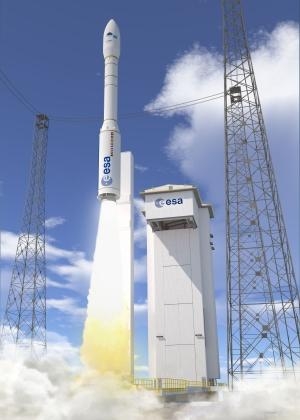Fri, Jan 20, 2012
ESA's Completes Final Checks On New Launcher
Final checkout of Europe’s new Vega launcher was
completed a week ago Friday, marking another milestone towards
its maiden flight from Europe’s Spaceport in Kourou, French
Guiana. The first Vega launch campaign began in November with the
installation of the P80 first stage on the launch pad. The two
solid-propellant second and third stages were added to the vehicle,
followed by the AVUM – Attitude & Vernier Upper Module
– liquid-propellant fourth stage. All four stages have
undergone final acceptance, including the testing of the avionics,
guidance, telemetry, propulsion, separation pyrotechnics and safety
systems.

These steps culminated on 13 January with Vega’s
‘synthesis control checks’, where all systems were put
into launch mode for the vehicle’s final acceptance. This
included pressurising the AVUM propulsion systems that actuate the
thruster valves. The rocket’s elements were switched on from
the control bench to simulate the launch countdown. The onboard
software then took over and simulated the different stages of a
flight. The interfaces between the vehicle and the control bench
were also tested. The test review confirmed that everything ran as
expected and that the launcher is ready for flight.
In the next phase of launch preparations, the ‘upper
composite’ – the fairing and payload – will be
integrated, followed by final checkout of the fully assembled
launcher and the countdown rehearsal. The first launch, VV01, is
targeted for 9 February. It will carry nine satellites into orbit:
the Italian space agency’s LARES and ALMASat-1, together with
seven CubeSats from European universities. This mission aims to
qualify the Vega launch system, including the vehicle, its launch
infrastructure and operations, from the launch campaign to payload
separation and disposal of the upper module.
Vega is designed to cope with a wide range of missions and
payload configurations in order to respond to different market
opportunities and provide great flexibility. In particular, it
offers configurations able to handle payloads ranging from a single
satellite up to one main satellite plus six microsatellites. Vega
is compatible with payload masses ranging from 300 kg to 2500 kg,
depending on the type and altitude of the orbit required by the
customers. The benchmark is for 1500 kg into a 700 km-altitude
polar orbit. (Image provided by ESA)
More News
Aero Linx: International Federation of Airworthiness (IFA) We aim to be the most internationally respected independent authority on the subject of Airworthiness. IFA uniquely combi>[...]
Ultrahigh Frequency (UHF) The frequency band between 300 and 3,000 MHz. The bank of radio frequencies used for military air/ground voice communications. In some instances this may >[...]
A Few Questions AND Answers To Help You Get MORE Out of ANN! 1) I forgot my password. How do I find it? 1) Easy... click here and give us your e-mail address--we'll send it to you >[...]
From 2019 (YouTube Edition): Learning To Paint Without Getting Any On Your Hands PPG's Aerospace Coatings Academy is a tool designed to teach everything one needs to know about all>[...]
Also: Sustainable Aircraft Test Put Aside, More Falcon 9 Ops, Wyoming ANG Rescue, Oreo Cookie Into Orbit Joby Aviation has reason to celebrate, recently completing its first full t>[...]
 ANN's Daily Aero-Linx (05.06.25)
ANN's Daily Aero-Linx (05.06.25) ANN's Daily Aero-Term (05.06.25): Ultrahigh Frequency (UHF)
ANN's Daily Aero-Term (05.06.25): Ultrahigh Frequency (UHF) ANN FAQ: Q&A 101
ANN FAQ: Q&A 101 Classic Aero-TV: Virtual Reality Painting--PPG Leverages Technology for Training
Classic Aero-TV: Virtual Reality Painting--PPG Leverages Technology for Training Airborne 05.02.25: Joby Crewed Milestone, Diamond Club, Canadian Pilot Insurance
Airborne 05.02.25: Joby Crewed Milestone, Diamond Club, Canadian Pilot Insurance



